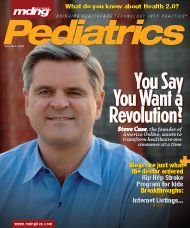Publication
Article
MDNG Pediatrics
Chief Concerns: Health 2.0 Is Making Waves
It's hard to believe that it's now close to a year since the initial Health 2.0 conference in San Francisco, CA in September 2007! Now, there's a vibrant Facebook group, a dynamic Health 2.0 blog, and a conference planned for October 21-23, 2008 in San Francisco, CA.
It’s hard to believe that it’s now close to a year since the initial Health 2.0 conference in San Francisco, CA in September 2007! Now, there’s a vibrant Facebook group, a dynamic Health 2.0 blog, and a conference planned for October 21-23, 2008 in San Francisco, CA.
We are in the midst of the third healthcare revolution. Gone are the days in which the fl ow of information and services is dictated only by the providers, hospital systems, pharma companies, and payers. We now have Web 2.0 tools like blogs, wikis, podcasts, and user-generated video. Th e stakeholders have slowly started to incorporate these new media outlets into their communication system. Physicians have started blogs and are conducting podcasts, which are especially appealing to the adolescent age group. And sites like Live MD Expert allow patients to consult with specialists via e-mail and via live video conferencing. Th is allows parents to obtain second opinions without having to worry about the burden of dragging their children to multiple appointments.
In January 2007, a revolutionary website, eDrugSearch, was launched, with the core mission of enabling consumers to safely search for low-cost drugs from Canadian and other international pharmacies. Th is social networking forum allows patients to glean new information by sharing their unique perspectives on their condition and treatment options with each other, rather than relying on direct-to-consumer advertising and rushed physician visits. Additionally, consumers have an opportunity to rate and review drugs and pharmacies, as well as meet and make friends with others who have the same disease. A recent survey of healthcare consumers revealed that only 19% of respondents were likely to research ratings information on hospitals or doctors and would change providers if the one they originally preferred received a low rating. However, this translates into 40 million adults, a large body of patients and parents of patients that is one of the many driving forces behind Health 2.0. Online social networking is a powerful new “human” engine that is making waves in healthcare. It started with the arrival of LinkedIn, MySpace, Friendster, and Facebook. Simple social communication made a leap into the multiple vertical domains of human knowledge. The premise behind this so-called Health 2.0 movement is simple; parents are tired of not knowing the whos, whys, hows, and what-fors associated with the care their children are receiving from their doctors. Th ey are now demanding the opportunity to talk over the diagnosis and treatment options with other parents.
Th ere are a number of websites that really exemplify the ideals of Health 2.0. Patients Like Me is a community of people with chronic diseases sharing fi rsthand information about the pros and cons of various treatment options. Sermois geared toward medical professionals, and allows them to exchange clinical insights, observations, and review cases in real time. Th ey currently have a network of more than 60,000 physicians. DoubleCheckMD exemplifies Health 2.0 and places the patient’s family in the driver’s seat. It uses natural language recognition to allow consumers to search medical texts and match symptoms with the medications they are taking. One important aspect of Health 2.0 is that it empowers families to rate their healthcare providers and make decisions based on the ratings of other families. Vitals.com uses an algorithm extracted from physician reviews of their peers to create a one-stop shop for information about physicians. One of the most innovative sites is Carol.com; this site’s goal is to try to solve ineffi ciencies in the current healthcare system, aiming to put consumers in control of which healthcare providers their children see and how much they want to pay by using “care packages.” Health 2.0 has made tremendous strides in the past year, and as this initiative is being spread via viral marketing at a rapid pace, the next year is destined to be even more exciting.
Dr. Newmark is the physician editor-in-chief of MDNG: Pediatrics Edition, and a pediatric endocrinologist in the Ambulatory Care Center at the Saint Barnabas Medical Center in Livingston, NJ.
